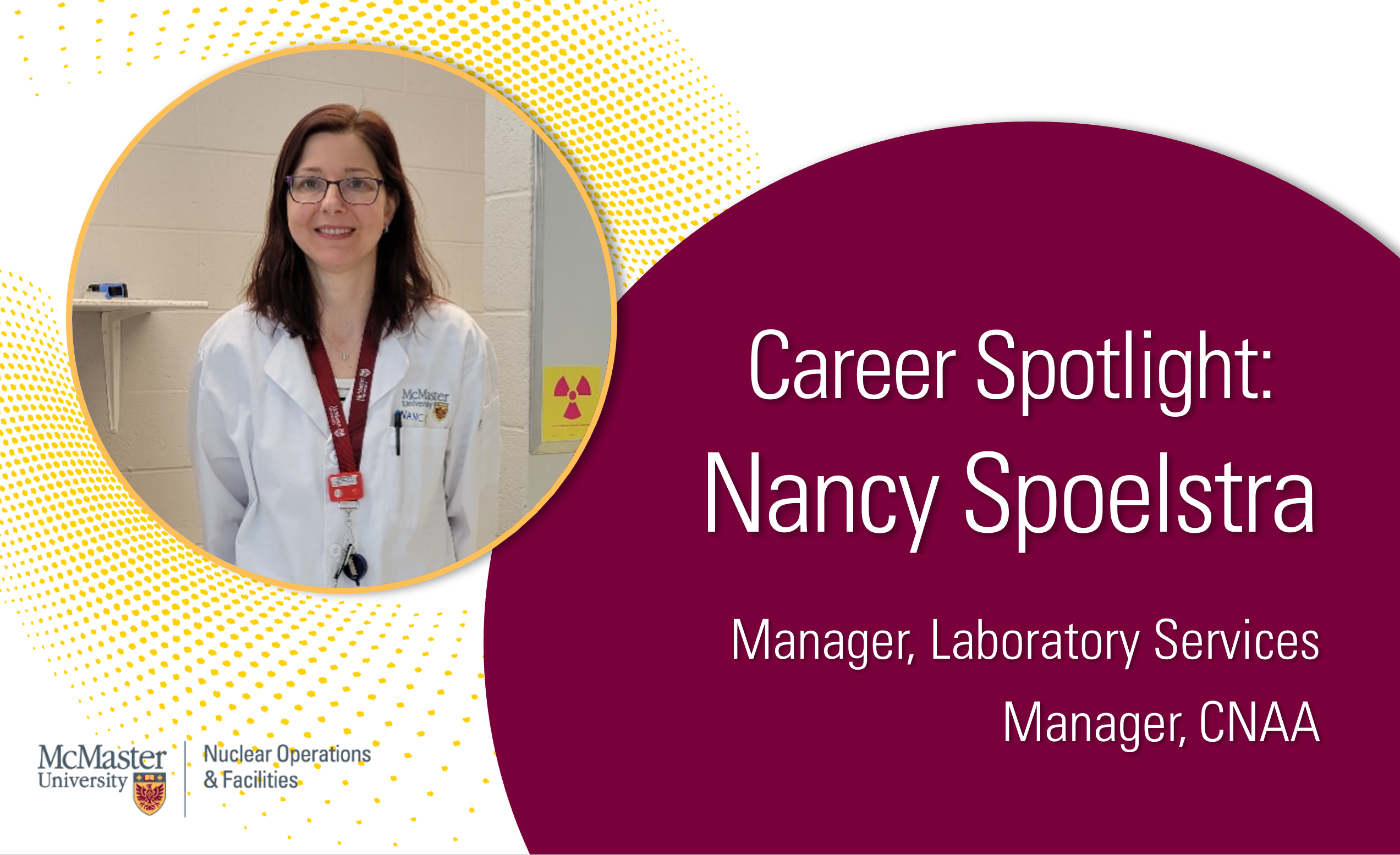Career Spotlight: Nancy Spoelstra

Nancy Spoelstra joined the NO&F team last summer. Since then, she’s been settling into her role as Nuclear Operations & Facilities’ Manager of Laboratory Services and Manager of the Centre for Neutron Activation Analysis (CNAA) – a position that was previously held by one of her mentors. In the interview below, Nancy walks us through the process of neutron activation analysis and shares a memorable lesson from her Grade 11 chemistry class that set her up for an exciting career in nuclear chemistry.
What is your role at Nuclear Operations and Facilities?
My title is Manager of Laboratory Services and Manager of the Centre for Neutron Activation Analysis (CNAA). I’m responsible for all the samples that come through the CNAA. I arrange the analyses and provide the raw data or the finished certificate of analyses to customers. I also aid with the quality control (QC) review and final stock approvals for McMaster’s iodine-125 medical isotopes.
What is neutron activation analysis (NAA)?
Neutron activation analysis is a method we use to determine the elemental composition of a sample. We take samples, which are usually materials like soil or rocks, and irradiate them inside the McMaster Nuclear Reactor. This causes a portion of the materials’ atoms to undergo neutron capture, producing high-energy compound nuclei that transform into short-lived radioactive isotopes. We allow these radioisotopes to decay for a period of time, during which we quantify, or “count,” the samples using gamma detectors. This means that we measure the gamma radiation emitted by the radionuclides present in the sample, which tells us information about the sample’s elemental composition.
What makes NAA a useful method for studying samples?
One of the great things about NAA is that it is a non-destructive process. We irradiate samples for a very short period of time, so their radioactivity decays quickly – to the point where the samples emit little to no radiation. This is beneficial for our customers, especially when they have a small quantity of a sample, as they can submit the sample to further kinds of testing after the neutron activation analysis is completed.
What did you study in college, and where did you work prior to NO&F?
I went to Mohawk College after high school, where I studied Chemical Engineering Technology. Right out of college I got a job as a lab technician at Activation Laboratories (Actlabs) in Ancaster, Ontario, where I worked for over 18 years in many different roles. Previously, I was the manager of their neutron activation lab. Actlabs’ neutron activation lab primarily serviced geological-based companies; mining companies all around the world would send samples to Actlabs for various kinds of testing.
Actlabs would often send samples to McMaster to be irradiated inside the nuclear reactor. Way back in the day, I would come to McMaster and analyze the samples myself in McMaster’s high-level labs. Over time, I got too busy to analyze the samples myself, so Alice Pidruczny – NO&F’s previous Manager of Laboratory Services – and her team would analyze them. I worked with Alice during my entire career at Actlabs.
What has it been like taking over the role of a mentor?
It’s very intimidating to take over the position of a mentor, but it’s also an honour and very humbling too. Throughout my career, whenever I had questions related to neutron activation, Alice was always someone I could call up and ask for an opinion. Alice has supported me throughout my entire career and when I heard she was retiring and that I was given an opportunity to apply for the position, I thought there was no way I could fill Alice’s shoes! I am looking forward to growing into the role and developing a wealth of knowledge that I can hopefully share with others in my field, like Alice did for me.
Was there an experience in your education that inspired you to study chemistry?
Absolutely! It was one of my Grade 11 chemistry classes. We were talking about sodium chloride, and I distinctly remember my teacher explaining that sodium metal can burn or explode in the presence of water, and chlorine is a toxic gas. Yet when you put sodium and chlorine together, it makes salt – which is what we had on our french fries at lunch! It just blew my mind that these two potentially dangerous things combine to make something that we eat. I fell in love with chemistry, and I knew that chemistry was the route I wanted to take. What I wanted to do in chemistry was up for debate. I originally took it to get into pharmaceutical manufacturing, but when the opportunity in the geology field came up, I thought, “This sounds interesting too.” I don’t think there’s any branch of chemistry that I wouldn’t find fascinating.
What is something you like to do in your spare time?
I love to ski! Now that my son is five and fearless, my partner and I are hoping to get him on skis this year so we can have family ski vacations. I’m looking forward to getting back on the slopes.
Blog